How to Get on a Surfboard
Getting on the surfboard
Getting up on the surfboard from the wave starting with some tests of getting up on the surfboard on the beach

To stand up on the surfboard, paddle into the wave (crawl style), head high and back arched so that your shoulders are almost perpendicular to the sea.

Hands under chest at shoulder level

Hands flat on the board to stretch your arms

Once the trunk is raised, bring the leg forward

Crouched position before getting up on the surfboardCrouched position with the knee of the front leg just under the chin, with the feet shoulder-width apart
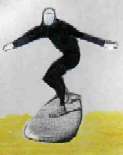
From here, stand up with your feet flat on the board with the same distance, with the central stringer passing under your feet and with your feet at an angle of about 90 degrees to the stringer; your arms open outwards to seek more balance.
Getting up on the surfboard in the water
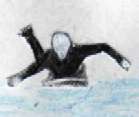
Paddle to catch the wave (crawl style), head high and back arched so that your shoulders are almost perpendicular to the sea
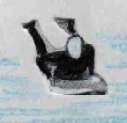
Hands under chest at shoulder level, The surfer feels the board being lifted from the wave, brings his hands to the board at shoulder level ready to straighten his arms and arches his back to avoid sinking the nose of the board.

Hands flat on the board to straighten your arms, Bring your legs forward, you find yourself in a crouched position with the front leg just under the chin and with a distance between the feet equal to the width of the shoulders, the front foot with a small angle to the central beam while the back foot with an angle of about 45°-90° degrees to the central beam.

Once your trunk is raised, bring your leg forward, From this crouched position, lift your arms off the board.
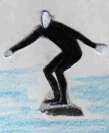
Crouched position with the knee of the front leg just under the chin, with the feet shoulder-width apart, Arms facing outwards and with knees always slightly bent in search of greater balance
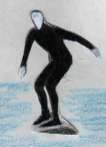
By shifting your weight to your front or back foot you can raise or lower the nose of the board, causing either a reduction or an increase in speed respectively. Head straight for the beach.
Standing on a surfboard in the middle of the waves is an art that requires balance, coordination and a good dose of determination. Surfing is much more than a water sport; it is a marriage between the surfer, the board and the ocean. The beginning of this fascinating process involves choosing the right wave. An expert surfer carefully evaluates the shape and energy of the wave, positioning himself strategically so as to maximize its force.
Once the right wave has been identified, the surfer begins his approach. The position on the board is crucial: with the body centered and the knees slightly bent, the surfer prepares to capture the energy of the wave. When the wave begins to rise, the critical moment arrives: the surfer pushes hard upwards, trying to quickly stand up on the board.
The hands are essential for maintaining balance. Placed on the sides of the board, they act as anchor points as the surfer lifts himself up with his legs. The transition from prone to standing requires perfect synchronization. The knees gradually extend as the body rises, trying to keep the weight centered on the board.
Once standing, the surfer is ready to ride the wave. Posture is essential: the body flexible, the arms slightly bent and the gaze fixed ahead. Every movement must adapt to the changing dynamics of the wave. Standing up on a surfboard is more than just a physical skill; it is an intense dialogue between the surfer and the unpredictable force of nature, a magical moment in which man dances on the water in harmony with the sea.
Getting up on the surfboard is a crucial step for any budding surfer, and practicing on the beach is an essential way to perfect this skill before hitting the waves. First, the surfer positions himself on the sand with the board in a horizontal position. This moment is essential to understanding the correct positioning of the body and hands.
The surfer begins in the prone position, with the body flat on the board and the hands at the sides. This starting position helps develop sensitivity to the board and familiarize the surfer with direct contact between the body and the surface. Since there is no wave to push on the beach, the surfer uses the strength of the arms to gradually lift the body. The movement should simulate the action of standing up while riding a wave.
The body weight is distributed between the hands and feet as the surfer mimics the process of standing up on a surfboard. Consistent practice helps improve balance and coordinate the movement of the legs. The knees bend and extend in a fluid rhythm, mimicking the natural process of standing up on a board during a surfing session. The hands are essential for maintaining balance, and consistent practice helps develop the necessary strength and coordination.
Simulating the action of getting up on the beach is an essential step in preparing for the dynamic challenges of the waves. The beach becomes the gym where the surfer hones his skills, successfully anticipating the moment when he will be on the water, ready to face the waves with confidence and style.
Getting up on a surfboard is an art that requires practice and mastery of balance dynamics. A fundamental step in this experience is the correct application of wax on the board, a key element to ensure a non-slip surface and good grip while surfing.
First of all, the board must be cleaned of any sand or dirt. Once the board is ready, you start by applying a base coat, a thin layer of harder wax, over the entire surface. This creates a solid base on which to apply subsequent layers of softer wax.
The critical part of waxing is concentrated in the area where the surfer places his feet while riding. This area, called the “deck,” is usually located on the top of the board. A generous layer of softer wax is applied to this area, creating a rough surface that allows the foot to grip firmly as the surfer stands up on the board. This is especially important to avoid unwanted slipping while riding.
Proper wax application is a crucial element to the success of any surfer. The experience of getting up on the board begins with the feeling of traction under the feet, allowing the surfer to distribute weight evenly and react to changes in the wave with greater control. Additionally, wax plays an important role in ensuring safety and stability, allowing the surfer to face the challenges of the ocean with confidence and agility.
The choice of surf wax is a crucial aspect to ensure optimal performance in the water, considering the different temperatures of the ocean. There are different types of wax specifically designed to adapt to climatic and thermal variations of the water, providing the surfer with the right grip in every condition.
For cold water, generally below 15 degrees Celsius, it is recommended to use a harder wax. This type of wax resists cold temperatures better, providing greater grip when the water is colder and the board may be more slippery.
For medium water temperatures, between 15 and 20 degrees Celsius, medium hardness wax is the ideal choice. This type of wax offers a good compromise between adhesion and glide, effectively adapting to intermediate water conditions.
In warmer waters, above 20 degrees Celsius, it is best to use a softer wax. Higher temperatures can make the board more slippery, and the soft wax helps offset this challenge by providing a more effective anti-slip surface.
The correct choice of wax based on water temperatures is essential to optimize the performance of the surfer. Accurate application of wax to the board, considering the thermal conditions, allows the surfer to stand up with confidence, maintaining control over the board in any marine environment. Therefore, armed with the right wax, surfers can face the challenges of the ocean with greater confidence and mastery of their skills.
